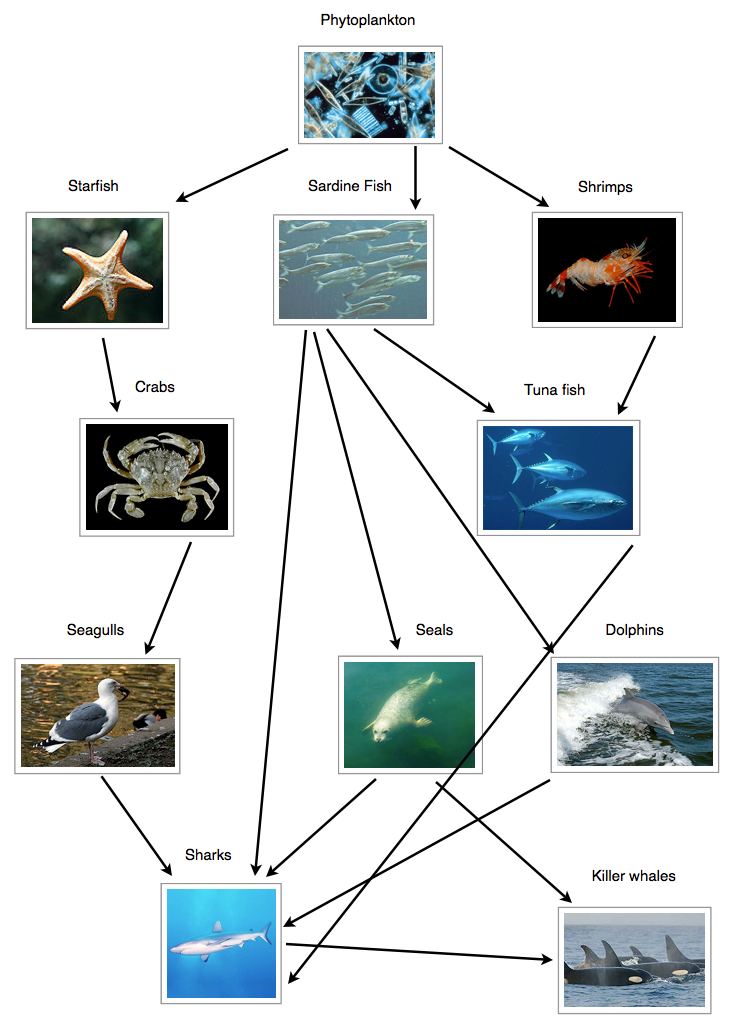Communities and ecosystems
5.1.1 Define species, habitat, population, community, ecosystem and ecology.
Species: a group of organisms that can interbreed and produce fertile offspring.
Habitat: the environment in which a species normally lives or the location of a living organism.
Population: a group of organisms of the same species who live in the same area at the same time.
Community: a group of populations living and interacting with each other in an area.
Ecosystem: a community and its abiotic environment.
Ecology: the study of relationships between living organisms and between organisms and their environment.
5.1.2 Distinguish between autotroph and heterotroph.
Autotrophs are organisms that synthesize their organic molecules from simple inorganic substances whereas heterotrophs are organisms that obtain organic molecules from other organisms.
5.1.3 Distinguish between consumers, detritivores and saprotrophs.
Consumer: an organism that ingests other organic matter that is living or recently killed.
Detritivore: an organism that ingests non-living organic matter.
Saprotroph: an organism that lives on or in non-living organic matter, secreting digestive enzymes into it and absorbing the products of digestion.
5.1.4 Describe what is meant by a food chain, giving three examples, each with at least three linkages (four organisms).
A food chain shows the direction of energy flow from one species to another. For example, an arrow from A to B means that A is being eaten by B and therefore indicates the direction of the energy flow.

Figure 5.1.1 - Example of a food chain
5.1.5 Describe what is meant by a food web.
A food web is a diagram that shows all the feeding relationships in a community with arrows which show the direction of the energy flow.
5.1.6 Define trophic level.
Trophic level: the trophic level of an organism is its position in the food chain. Producers, primary consumers, secondary consumers and tertiary consumers are examples of trophic levels.
5.1.7 Deduce the trophic level of organisms in a food chain and a food web.
Plants or any other photosynthetic organisms are the producers. Primary consumers are the species that eat the producers. Secondary consumers are the species that eat the primary consumers and tertiary consumers in turn eat the secondary consumers.
5.1.8 Construct a food web containing up to 10 organisms, using appropriate information.

Figure 5.1.2 - Food web
5.1.9 State that light is the initial energy source for almost all communities.
Light is the initial energy source for almost all communities.
5.1.10 Explain the energy flow in a food chain.
Producers receive their energy from light energy (the sun) by means of photosynthesis. After this, the energy in organic matter flows from producers to primary consumers to secondary consumers to tertiary consumers. This is because producers will be eaten by primary consumers which in turn will be eaten by secondary consumers and so on. However, between these trophic levels, energy is always lost. All of the trophic levels lose energy as heat through cell respiration. Also, as the organic matter passes from one trophic level to the next, not all of it is digested and so we have loss of energy in organic matter through feces. This energy then passes on to the detritivores and saprotrophs. Another energy loss occurs through tissue loss and death which can happen at any trophic level. Once again, this energy would be passed on to detritivores and saprotrophs as they digest these. Detritivores and saprotrophs in turn lose energy as heat through cell respiration.
Summary:
- Energy flows from producers to primary consumers, to secondary consumers, to tertiary consumers...
- Energy is lost between trophic levels in the form of heat through cell respiration, faeces, tissue loss and death.
- Some of this lost energy is used by detritivores and saprotrophs. These in turn also lose energy in the form of heat through cell respiration.
5.1.11 State that energy transformations are never 100% efficient.
Energy transformations are never 100% efficient.
5.1.12 Explain reasons for the shape of pyramids of energy.
5.1.13 Explain that energy enters and leaves ecosystems, but nutrients must be recycled.
Energy is not recycled. It is constantly being supplied to ecosystems through light energy and then flows through the trophic levels. As it flows through the trophic levels energy is lost in feces, tissue loss and death. This energy from these losses is passed on to detritivores and saprotrophs. However the energy is then lost from the ecosystem as the remaining energy in the trophic levels and the energy in the saprotrophs and detritivores is lost through cell respiration in the form of heat. As a result, energy needs to be constantly supplied to the ecosystems. Nutrients on the other hand are different as they constantly have to be recycled. Carbon, nitrogen and phosphorus are all examples of nutrients. There is only a limited supply of these as they are not resupplied to the ecosystems like energy. Therefor they have to be recycled over and over. They are absorbed from the environment, used by living organisms and then returned to the environment.
Summary:
- Energy is not recycled. Constantly being supplied to the ecosystem through light energy.
- Energy is lost from the ecosystem in the form of heat through cell respiration.
- Nutrients must be recycled as there is only a limited supply of them.
- They are absorbed by the environment, used by organisms and then returned to the environment.
5.1.14 State that saprotrophic bacteria and fungi (decomposers) recycle nutrients.
Saprotrophic bacteria and fungi (decomposers) recycle nutrients.
